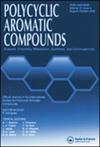茚二o[1,2-b]吡啶-5- 1衍生物的合成、抗菌、抗生物膜性能及对接研究
IF 2.6
3区 化学
Q2 CHEMISTRY, ORGANIC
引用次数: 0
摘要
在此背景下,我们设计并合成了一系列肼基及其相关的茚[1,2-b]吡啶-5- 1衍生物,以研究它们的抗菌和抗生物膜性能。几种合成的化合物对所有微生物都有显著的抑制作用。大多数化合物在抗革兰氏阳性菌试验中表现出良好的效果。其中,4a、4f、6c和6f的最小抑菌浓度(MIC)为4 ~ 512 μg/mL,抑菌效果最好。我们对4a、6c和6f进行了额外的研究,目的是使用棋盘法检查它们的协同作用。化合物6c对甲氧西林敏感金黄色葡萄球菌(MSSA)和铜绿假单胞菌具有协同作用,对耐甲氧西林金黄色葡萄球菌(MRSA)具有中等协同作用。此外,庆大霉素与化合物4a和6f同时使用,分别在对抗耐甲氧西林金黄色葡萄球菌(MRSA)和铜绿假单胞菌方面具有协同作用。对选定的三种化合物进行了抗菌效果评价。4a、6c和6f的应用有效地减少了MRSA、MSSA和铜绿假单胞菌中生物膜的产生,与未处理的样品相比显著减少。此外,对三种最有效的衍生物4a、6c和6f进行了ADME和药代动力学分析。化合物4a和6c与LasR群体感应受体对接,而化合物6c和6f与分选酶对接。本文章由计算机程序翻译,如有差异,请以英文原文为准。
Synthesis, Antibacterial, Anti-Biofilm Properties, and Docking Study of Indeno[1,2-b]Pyridin-5-One Derivatives
In this context, we designed and synthesized a series of hydrazonal and their related indeno[1,2-b]pyridin-5-one derivatives to investigate their antibacterial and anti-biofilm properties. Several of the synthesized compounds exhibited significant efficacy against all microorganism species tested. Most of the compounds demonstrated favorable results when tested against Gram-positive bacteria. The derivatives 4a, 4f, 6c, and 6f exhibit the highest antimicrobial efficacy, as indicated by their minimum inhibitory concentration (MIC) values ranging from 4 to 512 μg/mL. We conducted additional investigations on 4a, 6c, and 6f for the purpose of examining their synergy using Checkerboard assay. Compound 6c demonstrated a synergistic impact against methicillin-sensitive Staphylococcus aureus (MSSA) and Pseudomonas aeruginosa, while exhibiting moderate synergistic activity against methicillin-resistant Staphylococcus aureus (MRSA). In addition, the simultaneous use of gentamycin with compounds 4a and 6f demonstrates a synergistic impact in fighting against methicillin-resistant Staphylococcus aureus (MRSA) and Pseudomonas aeruginosa, respectively. Three chosen compounds were evaluated for their antibiofilm efficacy. Application of 4a, 6c, and 6f effectively reduced the production of biofilms in MRSA, MSSA, and Pseudomonas aeruginosa, resulting in a significant decrease compared to the untreated samples. In addition, ADME and pharmacokinetic analyses were conducted for the three most potent derivatives, namely 4a, 6c, and 6f. Compounds 4a and 6c were subjected to docking in the LasR Quorum-Sensing Receptor, whereas compounds 6c and 6f were docked in the sortase enzyme.
求助全文
通过发布文献求助,成功后即可免费获取论文全文。
去求助
来源期刊

Polycyclic Aromatic Compounds
化学-有机化学
CiteScore
3.70
自引率
20.80%
发文量
412
审稿时长
3 months
期刊介绍:
The purpose of Polycyclic Aromatic Compounds is to provide an international and interdisciplinary forum for all aspects of research related to polycyclic aromatic compounds (PAC). Topics range from fundamental research in chemistry (including synthetic and theoretical chemistry) and physics (including astrophysics), as well as thermodynamics, spectroscopy, analytical methods, and biology to applied studies in environmental science, biochemistry, toxicology, and industry. Polycyclic Aromatic Compounds has an outstanding Editorial Board and offers a rapid and efficient peer review process, as well as a flexible open access policy.
 求助内容:
求助内容: 应助结果提醒方式:
应助结果提醒方式:


